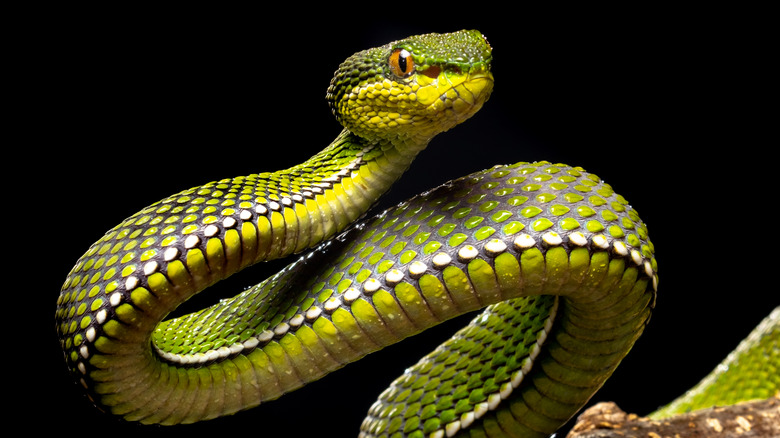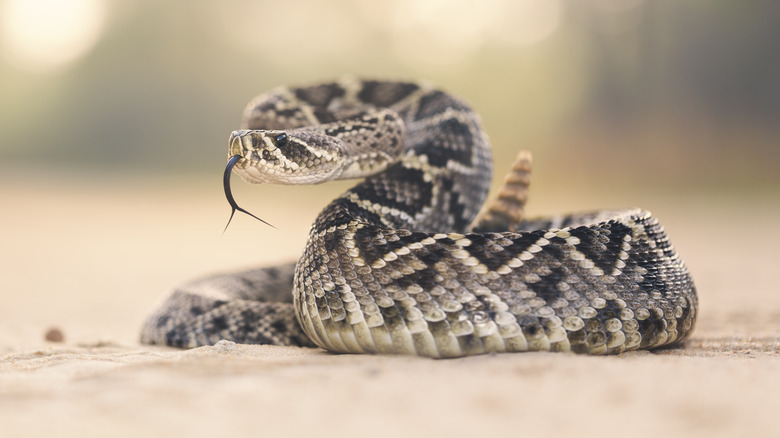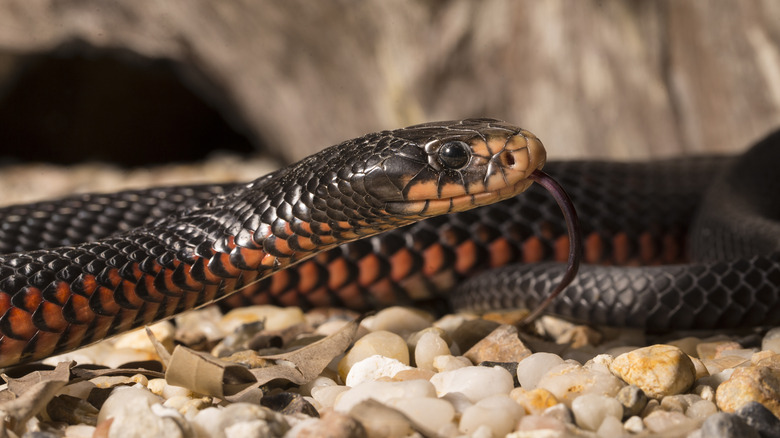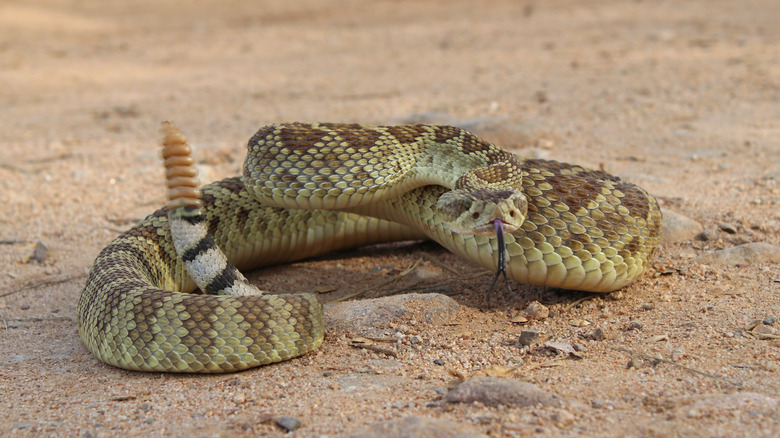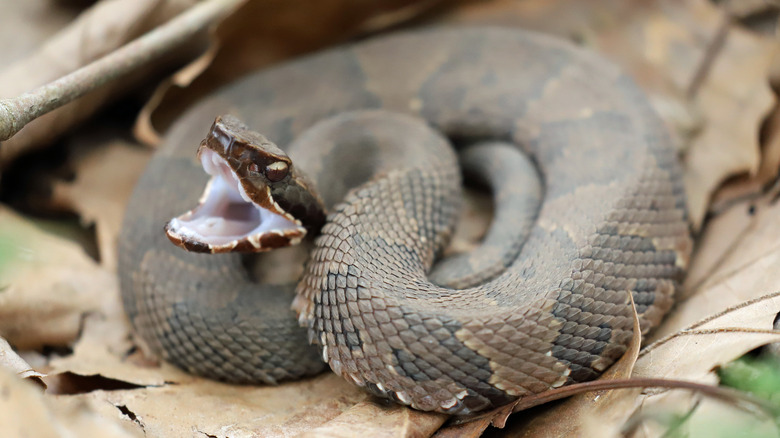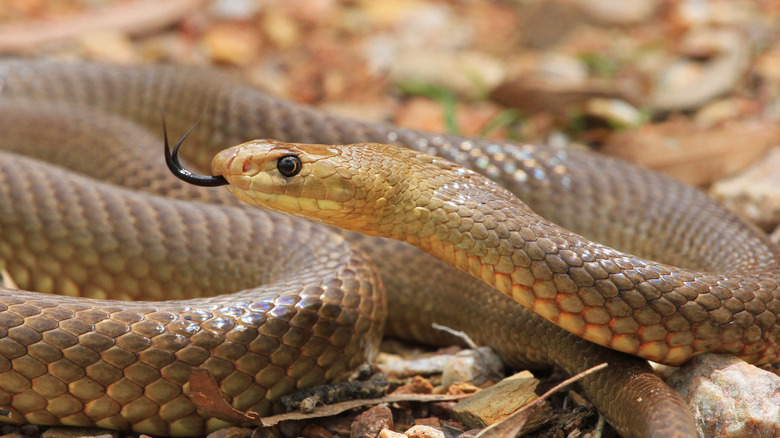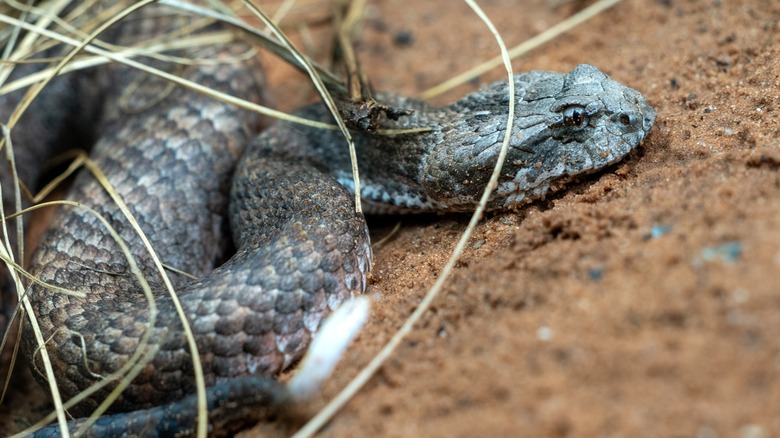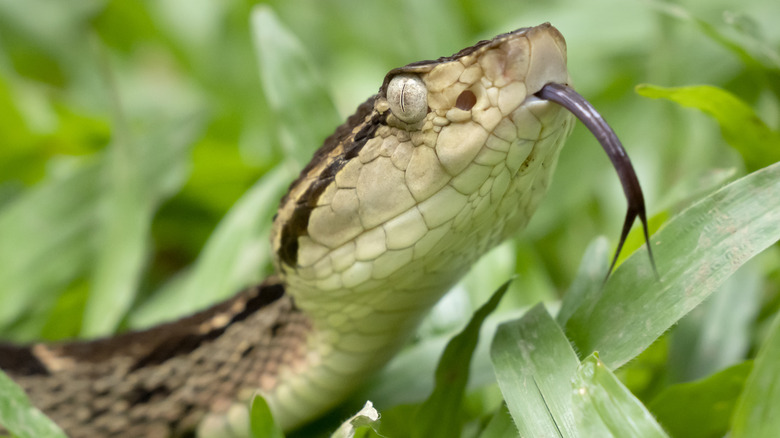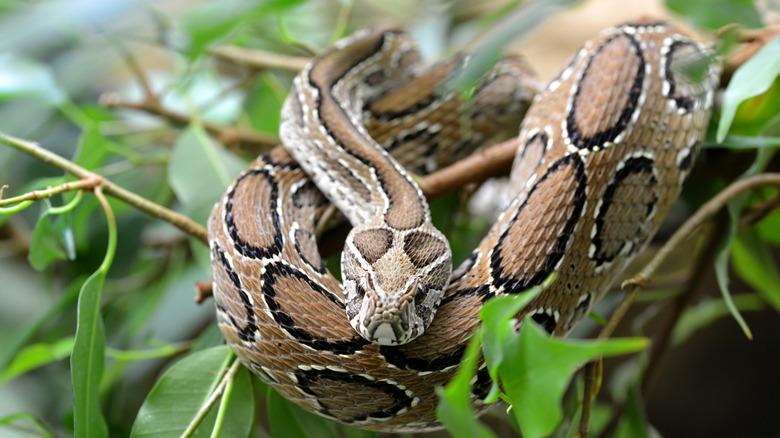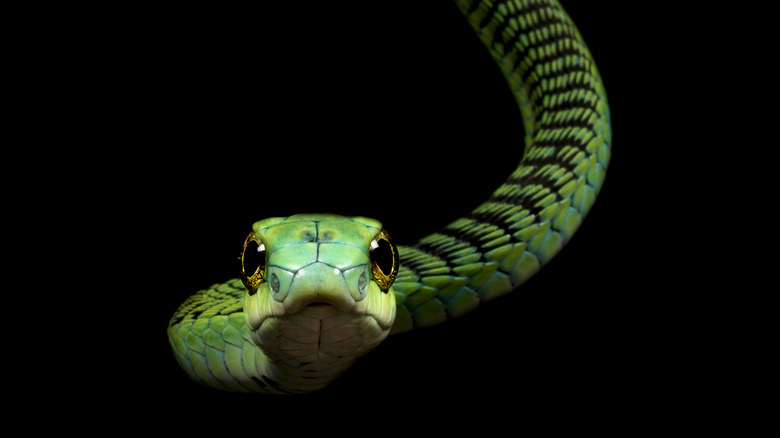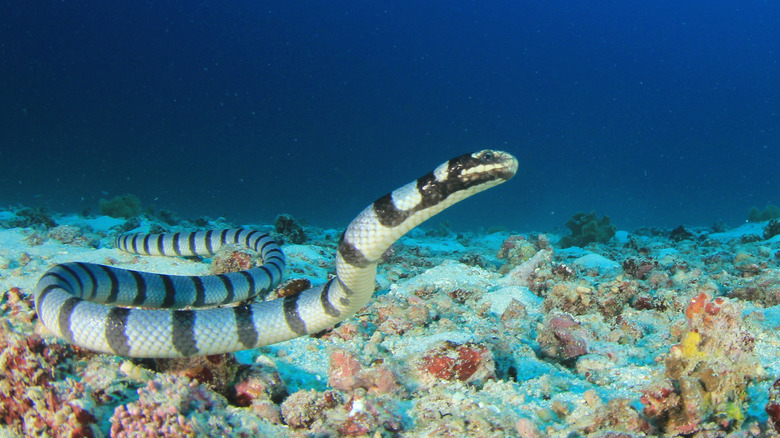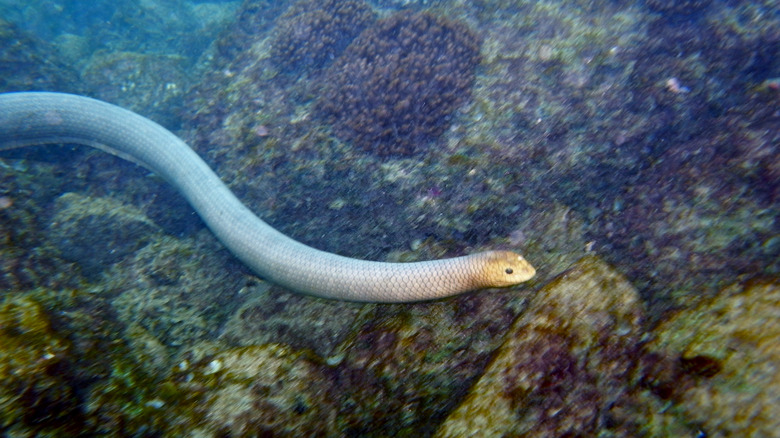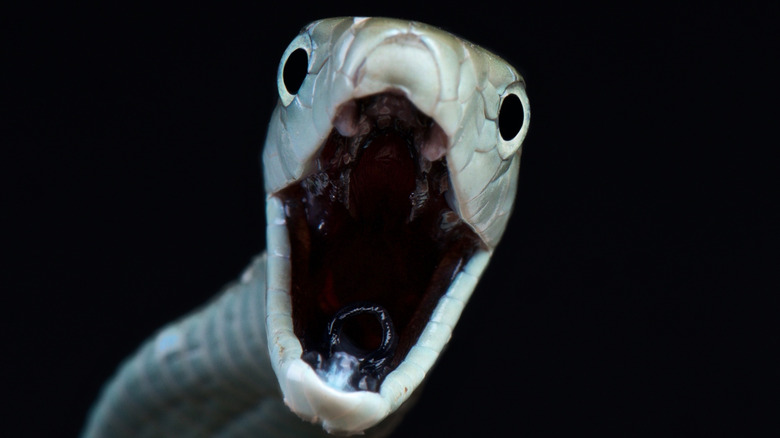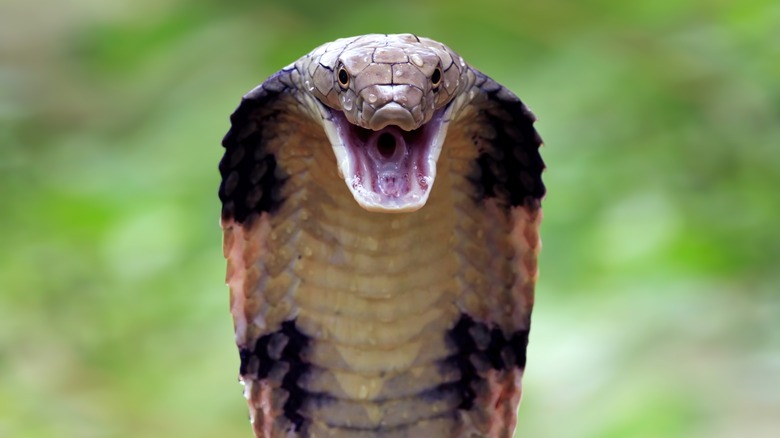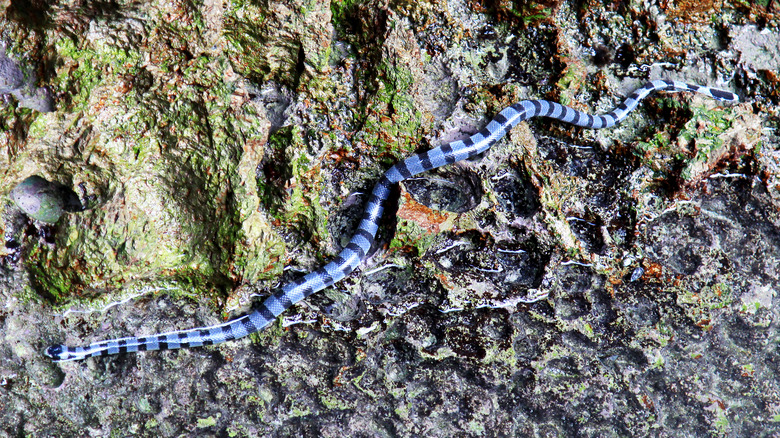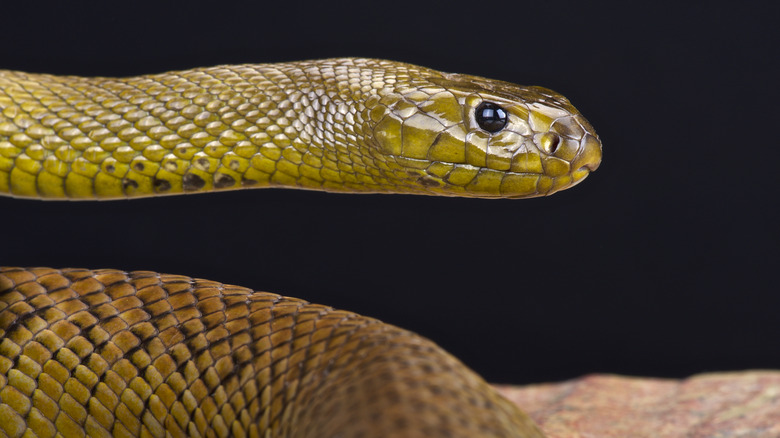20 Types Of Snakes, Ranked By Danger Level
People are not blasé about snakes. They either adore them or would like nothing more than to run away from them as fast as possible. There is a good reason to be in the latter camp. According to National Geographic, there are about 3,000 species of snakes on the planet, and around 600 of which are venomous, making them among the most dangerous animals in the entire world. Who hasn't gotten at least a little nervous when they hear the low hiss and sounds of rattling when they are out hiking?
Although the amount of venomous snakes that exist in the world may sound alarming, it's worthwhile mentioning that the majority of these creatures will not attack unless they are provoked. Snakes actually have a limited amount of venom, and would much rather conserve it for their prey. As Global Rescue notes, the majority of people who get bitten by snakes in the U.S. are those who try to pick them up or attack them.
While a lot depends on where you live, there are snakes to be found around the globe. We've compiled this list of 20 of the world's most dangerous snakes. Our rankings are gauged on the toxicity of the venom, how threatening it is to run across one of them in the wild, and the amount of annual human fatalities. Let's begin.
20. Eastern Diamondback Rattlesnake
We begin our list with the highly common Eastern diamondback rattlesnake (Crotalus adamanteus). The population spans across the southeastern United States, including Florida, Mississippi, Louisiana, Georgia, and The Carolinas. A hazardous snake, the Eastern diamondback is not one you want to get on the wrong side of. Their distinctive rattle is usually enough to ward people off, but if you happen to keep bothering it (or accidentally threatening it), it could go in for a bite (via Smithsonian's National Zoo and Conservation Biology Institute).
North America's most venomous snake, and the largest of its species in the world, the Eastern diamondback will release hemotoxic venom whenever it strikes out at its prey. The hemotoxins attack red blood cells and can be fatal to humans if left untreated. According to a study published in Cureus, around 1,989 non-fatal rattlesnake bites occur every year, with annual fatalities averaging 4 to 5 people. Enough to cause concern, for sure, but these numbers are nowhere close to others you'll be seeing on this list.
So, while the overall death rate is on the lower side, you will certainly be in a lot of pain if you're bitten by one of these snakes.
19. Red-Bellied Snake
If there is one continent you are going to see more than any others on this list, it's Australia. Known to be home to some of the deadliest creatures known to roam the earth, the wilds of Australia are not for the faint of heart. That being said, the amount of danger posed by Australia's snakes is high, as it is home to the most venomous snakes in the entire world. So, now that we've done our part for Australian tourism, let's examine the dangers of the red-bellied snake (Pseudechis porphyriacus).
Though the venom from this snake could very easily kill you, thanks to the potent mix of neurotoxins and mycotoxins that attack the nervous system and the bloodstream, the red-bellied snake occupies a lower ranking on this list because it is not the most aggressive snake in the world. In fact, it actually avoids contact with people wherever it can. You'll see this as a common theme throughout this list.
Living primarily on the eastern coast of Australia, the red-bellied snake is defined by the dark scales along its backside and the bright red ones that line its belly. Though rare, a non-fatal bite from one of these snakes can cause permanent muscle pain and a total loss of smell. There have, however, been no recorded human fatalities, per The New Daily.
18. Mojave Rattlesnake
There is an oft-paraphrased Shakespeare quote that we'll use to describe the Mojave rattlesnake (Crotalus scutulatus): Though it is but little, it is fierce. This might actually be something of an understatement. A native of the Mojave Desert in California, and with a range stretching through Nevada, Arizona, Texas, and Mexico, the Mojave rattlesnake is small, measuring a little over 3 feet in length. However, what they lack in size, they make up for in toxicity.
The Mojave rattlesnake has a powerful bite. It is not about to be warded off by your size because it knows that it can inflict a lot of damage. With a venom ten times more powerful than other North American rattlesnakes, with the exception of the Eastern diamondback, the Mojave will inject its neurotoxin into the bloodstream, which can cause significant nerve damage and even death.
In terms of overall fatality, though, bites from the Mojave range on the lower side. Despite the toxins in the venom being fatal to humans, there is enough medical support and anti-venom available in the United States that the last known death caused by one of these snakes was all the way back in 2007, per Advocates for Snake Preservation. So, once again, if you happen to aggravate this snake enough to get bitten, you'll be in a lot of pain, but you're very likely going to be okay.
17. Cottonmouth Moccasin
Unique among North American snakes, the cottonmouth moccasin (Agkistrodon piscivorus) is a water snake that lives in the swamps, ponds, and rivers of the southern United States. Distinguished by its dark scales and cotton-white mouth (hence the name), this snake is at home on the water and is buoyant enough to swim and hide on the water's surface.
Though the Cottonmouth may look particularly mean and enjoys showing off its white mouth when provoked, the snake is actually rather shy when it comes to human interaction. It prefers to hiss and spit as opposed to bite. This makes them relatively tame. However, if you do happen to irk one into biting you, usually by stepping on it or swimming by it, the results will be painful but not likely fatal.
Though roughly 7,000 to 8,000 people are bitten by venomous snakes in America every year, only about five or six of those incidents are fatal, according to the University of Florida. In terms of Cottonmouth bites, they amount for less than 1% of those deaths. The hemotoxin present in the cottonmouth's venom has the capacity to kill humans, but it all depends on how long the bite is sustained and how much venom is pumped in. Gauging from the lack of overall fatality, it's safe to assume that these snakes are actually quite timid when it comes to human contact.
16. Western Brown Snake
Coming back to Australia, we have the Western brown snake (Pseudonaja nuchalis). Found in the western mainlands of the continent, Western brown are among the island's least dangerous snakes. Not in terms of toxicity but in terms of temperament. Like the red-bellied snake, Western browns are not overly fond of people, and would rather slither away and hide as opposed to bite. This does not mean, however, that they do not have the potential to be extremely dangerous if cornered.
Though many of the other snakes on this list will have distinguished fangs and painful bites, the Western brown has neither. Its bites aren't much more than a pinch and are incredibly difficult to see owing to the fact that their fangs are small and don't leave much of an impression. But it's not the size of the bite that matters. It's what's in it.
The venom of a Western brown is not overly toxic, but they deliver a lot of it. According to Australian Geographic, the high dosage comes with some pretty serious side effects, including nausea, abdominal pain, severe blood clotting, hemorrhaging, and kidney damage. Depending on the health of those bitten, this could mean severe illness or even death. The brown snake family has been responsible for 23 of the 35 deaths in Australia caused by snakes between 2000 and 2016, according to the University of Melbourne.
15. Eastern Brown Snake
The Eastern brown snake (Pseudonaja textilis) might just be the most feared snake in Eastern Australia. This is because it causes the deaths of roughly two Australians per year, according to News AU. Unlike its shy cousin, the Western brown, the Eastern brown snake is one of the most outgoing snakes you'll encounter. This is likely due to the fact that it lives in the most populated area of the continent: the East Coast. Since densely-populated areas also attract rodents (a snake's tasty dinner), the Eastern brown snake has adapted to be more comfortable around people.
It only takes 3 milligrams of Eastern brown venom to kill an adult human. And seeing as the venom load of the average bite ranges from 5 to 75 milligrams, it's highly unlikely you're coming home from the hospital if you get bitten by one of these guys. Like many other snakes, its venom targets blood coagulation. The potency of Eastern brown venom removes the blood's ability to clot, which causes internal bleeding, hemorrhaging, and cardiac arrest in short to no time (via Australian Geographic).
14. Gaboon Viper
No snake fangs are larger than that of the gaboon viper (Bitis gabonica). A bite from a gaboon viper is going to be the deepest of any snake. The fact that they are venomous only adds to the danger level of these snakes. However, for all the ferocity of their looks, they don't actually pose that much of a threat to people.
An extremely large snake located in the rainforests of Central, East, and West Africa, the gaboon viper has a very calm disposition. It prefers to show off its fangs as a method of deterrence as opposed to fighting or biting. The reason for this is that, like most snakes, the gaboon viper does not like to waste its precious venom on something it can't eat. So, if you manage to irritate it enough to get bitten, it'll be really painful, but you won't be at too much risk of death because it's not likely to inject that much venom into you.
13. Death Adder
The death adder (Acanthophis antarcticus) is, as its name suggests, one of Australia's most deadly venomous land animals and looks like a creature that lives up to its name. With a triangular head and extremely dark or golden brown scales, the death adder is very good at camouflaging itself. An ambush hunter, these snakes rely on the fact that their prey cannot see them before they move in for the kill. This camouflage also makes them particularly dangerous to hikers, who could step on one accidentally and get caught in a world of trouble.
Despite the venom of a death adder being particularly potent, its effects can be cured with the right treatment. The death adder is not one of those snakes whose bite is going to make your life flash before your eyes in a matter of minutes. However, the mortality rate for untreated bites is very high, around 60%, according to Discover Wildlife. We should say, before we continue any further, that no bite from a snake should go untreated. Ever.
According to the University of Melbourne, the severity of a death adder bite depends on how much venom is injected into the prey. The typical load is around 85 milligrams, but they can also max out around 235 milligrams, which is incredibly fatal. A good bite, even one that is treated, has the ability to cause permanent paralysis.
12. Terciopelo
This extremely dangerous snake is a native of South and Central America. Called a terciopelo (Bothrops asper) or fer-de-lance, depending on who you're talking to, this snake packs a powerful punch with its bite. It carries the capability of releasing up to 1,500 milligrams of its powerful venom into the body of its victims, per World Atlas. Seeing as 3 milligrams are enough to kill one mouse, one bite from a terciopelo has the capacity to kill six people in one go.
Like the Eastern brown snake in Australia, the terciopelo lives in areas of high population density (since it can find more small prey to snack on). Therefore, its interactions with humans are far more frequent than other snakes might be — meaning you should stay away from them. The majority of bites occur in farm fields and plantations.
According to a 2013 study published in PLOS Neglected Tropical Diseases, terciopelo snakes account for 90% of all snake bites in Central and South America and a good portion of the Caribbean Archipelago. Adding to its fearsome reputation is its size. On average, the terciopelo can weigh upwards of 13 pounds and stretch as much as 8 feet long.
11. Russell's Viper
On the Indian subcontinent, there are what's known as "The Big Four." A far cry from the Hercule Poirot mystery of the same name, this Big Four are not so much a group of supervillains but rather the four most venomous and medically significant snakes in the region. A ranking member of this group is Russell's viper (Daboia russeli), an extremely venomous snake. Of all the Big Four, the Russell's Viper is the cause of the most bites, at a whopping 43% (via Discover Wildlife).
Though its fangs are not as long as that of the gaboon viper, the Russell's viper packs one of the most excruciatingly painful bites in all of the snakedom. With that bite comes the venom that kills between 15,000 and 20,000 people in India every year, per HCI. To put that into perspective, the latter number is just slightly under the population of Keene, New Hampshire, according to the latest Census data.
Seeing as the Indian subcontinent (which includes places like Sri Lanka, Nepal, Pakistan, the Maldives, and Bangladesh) is an enormous place packed with over a billion people, it is easy to see why this snake would come in contact with many humans. If you see it, just stay away.
10. Saw-Scaled Viper
Another ranking member of the Big Four, the saw-scaled viper (Echis carinatus) is perhaps the single deadliest snake in the world. If we are judging by the amount of fatalities in a given year, that is. It isn't the most venomous snake, but because it exists in one of the world's most densely populated areas, the Indian subcontinent, the saw-scaled viper kills an average of 30,000 people a year, per Fact Animal.
Despite the fact that they pose an extreme danger to life if you provoke it, saw-scaled vipers will nevertheless provide you with a unique warning sound should you get too close. Their scales produce a sizzling sound, almost like bacon frying in a pan. It's their way of telling you to back off.
It's worthwhile noting that the toxicity of this snake is relatively small, only killing roughly 10% of those whom it bites, and those wounds are even left untreated. The fact that it lives in an area whose population is so unbelievably high is solely to blame for the amount of casualties caused by this snake.
9. Forest Cobra
The only species of cobra to live in high-altitude forests, the forest cobra (Naja melanoleuca) is an African snake that can be found across several different habitats, including savannahs, woodlands, grasses, and bodies of water. With a habitat this broad and wild, the forest cobra does not come into contact with people too often. Though this lack of human interaction has led to an unknown mortality rate, the reason we list this snake so far down on the list is for one reason: the toxicity of its venom.
It may not bite that many people, but the forest cobra doesn't need to in order to be dangerous. A single bite from this beast contains enough toxic venom to take out 65 adult humans. One of the ways snake venom toxicity is measured is by an LD50 score. This, according to Learn About Nature, means that the lower the score, the more deadly the snake. The forest cobra has a score of 0.22 and can inject almost 1,100 milligrams of venom into a victim in a single bite.
If you ever happen to be one of the unlucky souls who does get bitten by a forest cobra, know that symptoms such as paralysis and organ failure can occur in as little as 30 minutes. Time, therefore, is not on your side, which is yet another reason to stay away.
8. Boomslang
Of all the snakes on this list, the boomslang (Dispholidus typus) could conceivably be called cute. Almost cartoonish in its looks, the boomslang has bright green scales and enormous, emotive eyes. For "Harry Potter" fans, the skin is also a vital ingredient in the making of Polyjuice Potion, as it turns out. However, hidden within the seemingly innocent demeanor lies an extremely deadly animal.
Though only 10 people have died worldwide as a result of its bite, according to McGill University, the venom of a boomslang is so rich in hemotoxins that it can cause severe internal bleeding and organ hemorrhaging. However, boomslang's secret weapon is the fact that its highly toxic venom works very slowly. If someone is bit by one, they might not know there's anything wrong until it's far too late. One good bite is enough to kill a person.
The big punch that is carried out by this little snake is one of the reasons why it should never be approached. However, it is also because of its size that bites are relatively rare from a boomslang. It does not tend to mess with that which is bigger than it can eat. Therefore, you're very likely to see a boomslang turn tail before it's sinking its teeth into you.
7. Blue Krait
It's often remarked how certain sea snakes are far more deadly than their land-dwelling cousins. This is true, to an extent. Take the blue krait (Bungarus candidus) as an example. According to Owlcation, its venom is 15 times more powerful than most cobras, making it by far one of the most deadly snakes on the face of the planet. A native of the waters of Southeastern Asia, this snake has been nicknamed "The Five-Step Snake" (via Snake Facts). The going theory is that you won't be able to walk five steps before you drop dead. This is an exaggeration, of course, but only just.
An untreated bite from a blue krait can kill an adult in as little as 12 hours. That death will not be remotely peaceful, as the venom from this snake can easily cause a total collapse of the nervous and respiratory system. In short, you won't be able to breathe, and you also won't be able to do anything about it. It's not a good way to go.
Fortunately, blue kraits also happen to be among the most tame snakes in the entire world. So much so, in fact, that they will let swimmers and divers pick them up without issue. It's somewhat ironic that this most gentle of snakes also happens to be among the most deadly.
6. Dubois' Sea Snake
Like their cousin, the blue krait, Dubois' sea snakes (Aipysurus duboisii) are highly docile creatures and live in relatively remote corners of the Pacific and Indian Oceans off the coast of Australia. This is likely why there are very few records of this snake actually killing anyone. As a matter of fact, it is not known whether or not this snake has ever killed anyone. What is known, however, is that the bite of the Dubois' sea snake is enough to kill a passing swimmer.
The LD50 rating on the Dubois' is ridiculously low, 0.04, according to Guinness World Records. This rating actually makes it the most venomous sea snake in the entire world. But as we've seen previously, the toxicity of a snake does not always indicate total and complete danger. You're more likely to be bitten by a rattlesnake than you are a Dubois' sea snake.
So why bother putting it so high on this list? For the simple reason of the fact that the toxins within the snake can 100% kill a person in a relatively short period of time. With an LD50 rating that is below 1, the density and swiftness of the venom will kill someone within 30 minutes of being bitten. It's not likely to happen, of course, but the fact that it can should be enough to make you think twice before attempting to tussle with this snake.
5. Black Mamba
The name of the black mamba (Dendroaspis polylepis) is enough to fill anyone with terror. Like the cottonmouth moccasin, the black mamba's name comes from the fact that the inside of its mouth is jet black. This provides you with an idea of how fearsome-looking it is. It doesn't help that this snake is one of the fastest in the entire world and can easily move for extended periods of time at 12 miles per hour (via National Geographic). Therefore, the black mamba is going to have no trouble catching up to whoever was foolish enough to tick it off.
Described as a more skittish than an aggressive snake, the mortality rate from a bite by a black mamba is 100%. This means that if you're bitten by one, it's all over. According to Britannica, two drops of black mamba venom are enough to kill a person. The toxins affect the heart and nervous systems, causing cardiac arrest and a shutdown of vital organs.
Fortunately, the black mamba is not one to fight unprovoked, so just stay away. A native of Southern Africa, this snake is said to be the deadliest on the continent. It's easy to see why.
4. King Cobra
The world's longest, deadliest, and most iconic cobra, the king cobra (Ophiophagus hannah) is one of the scariest, yet most fascinating, looking snakes in the entire world. A favorite of snake charmers on the Indian Subcontinent, king cobras are defined by the wide hoods that frame their heads. They are quite shy, and will not attack unless provoked. Though they are not part of the Big Four, their venom is among the most toxic in the entire world.
A mix of cytotoxins and neurotoxins, the venom of the king cobra will attack both the central nervous system and the heart. The venom works quickly to get into the bloodstream and can cause complete cardiovascular and nervous system failure, leading to a prolonged and painful death. According to Owlcation, 28% of all bites inflicted by these snakes are fatal.
They are, however, revered in India. Per Wildlife SOS, the penalty for killing one carries a maximum sentence of seven years in prison and a hefty fine. All of this to say, keep away from these snakes in general. You don't want to get caught killing or being killed by one.
3. Coastal Taipan
Now we come to the final three, those snakes that we consider to be the most dangerous in the entire world. Starting with the coastal taipan (Oxyuranus scutellatus), this highly venomous snake spends its time hunting along the coast of eastern Australia. It's not a small snake by any stretch of the imagination, measuring as long as 2 meters and having a relatively stocky build. It is also not afraid to show off its own lethality.
Never one to back down from a fight, the coastal taipan will attack with extreme ferocity if going after its prey. Highly nervous and jittery, you should just steer clear of them altogether. If provoked, it will inflict multiple, extremely painful bites very quickly and efficiently. The strikes go deep, and with them comes the venom.
According to The Daily Telegraph, the venom from a single bite of a coastal taipan is enough to kill 100, 000 mice. The horrible thing is that a venomous bite to a person can be fatal within 30 minutes. The toxins work fast to cause massive internal bleeding, respiratory failure, and death. According to the University of Melbourne, before the invention of an antivenom in the 1950s, bites from this snake were 100% fatal. Today, the average yearly deaths caused by the coastal taipan hover around 5.
2. Belcher's Sea Snake
Discovered in the 1800s by Sir Edward Belcher, Belcher's sea snake (Hydrophis belcheri) is considered by many experts to be among the most deadly sea snakes in the entire world. Endemic to the warm waters of the Indian Ocean and the Gulf of Thailand, this chrome and blue-scaled snake is highly shy of onlookers and swimmers. That is, unless it has been properly provoked.
The myo and neurotoxins found in the venom of a Belcher's sea snake are capable of killing an adult human within 30 minutes of being bitten (via Ocean Treasures Memorial Library). Symptoms onset quickly and include migraine-level headaches, body aches, sweating, vomiting, muscle stiffness, and lastly, paralysis, per Forbes. Bites are always fatal unless they are treated with an antivenom within the half-hour time window of being bitten. However, the snake can also choose whether or not to inject venom when it bites. According to Thai National Parks, only 25% of Belcher's sea snake bites are envenomed.
Now, owing to the scale of the ocean and the natural shyness of the snake, no real number indicates its overall mortality rate. However, what we do know is that the majority of incidents that have resulted in a bite from the Belcher's sea snake were a result of fishermen not spotting them in their nets.
1. Inland Taipan
Back to Australia for the single most deadly snake that slithers on the earth, the inland taipan (Oxyuranus microlepidotus). This snake is 100% as dangerous as it looks. As noted by NDTV, this snake is capable of injecting enough venom to kill 100 humans in a single bite. Prolific across almost all of Southern Australia, this is one snake that if you see slithering up your driveway, across your yard, or in the garden, just stay away.
Though not outwardly aggressive and actually quite shy, the amount of different toxins found within the venom of the inland taipan is what makes it so unbelievably dangerous. Neurotoxins, hemotoxins, nephrotoxins, and mycotoxins all work together to attack every single system within the body, including the skeletal system. Bites are always fatal if not treated, and death can take hold in as little as 30 minutes (via University of California San Diego).
However, as dangerous as this snake sounds, there have been zero recorded fatalities as a result of it biting someone. In fact, according to Billabong Sanctuary, no records exist of it ever inflicting a bite on anyone. So, as we mentioned, just steer clear of the inland taipan (or any of these other snakes mentioned), and enjoy its fascinating wild beauty from a distance.
